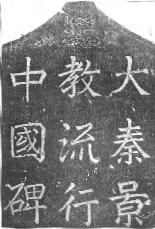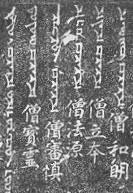|
|
 |

Top of the Nestorian stele of Xi'an-fu: 大秦景教流行中國碑 "Stele about the spread of the Persian Nestorianism in China"

Text from the stele with several names of monks in Syrian and Chinese
|
The Nestorian or Assyrian Church (in Chinese jingjiao 景教) is a kind of oriental national church ("church of the east") that was opposed against the Roman church after the concile of Ephesus in 431. The Assyrian Church is said to be founded by the apostles Thomas and Addai and was very widespread not only in Syria, Mesopotamia (modern Irak) but also in Persia where the katholikos of Ktesiphon-Seleukeia acted as bishop of the Eastern Church. The bishop again renounced the concile of Chalkedon in 451 and followed the teachings of Nestorios who believed in the unity of the human and divine nature of Jesus Christ, a dogma that was later manifested as the two hypostatic natures of the Christ (two natures, two persons, Chinese: erxing erwei 二性二位). The bishop of the Eastern Church acted as head of all eastern Christians and promoted the voyages of missionaries to India and Central Asia. From the 7th to the 11th centuries Nestorianism was the Christian sect with believers in the most widespread territory. There is a bilingue stele in Chinese and Syrian (Ugaritian) in the prefecture of Xi'an 西安府 (older texts write: Si-ngan-fu), erected in 781 and rediscovered in 1625 that reports the existence of Nestorian (Chinese: Niesituoli 聶思脫里) parishes in China since the begin of the 7th century. Nestorian monks lived in a "Persian" Yiningfang Monastery 大秦義寧坊寺 in Xi'an, and the first missionary was a Persian called "Aluoben" (Alopen) 阿羅本. After the expellation of foreign missionaries in the 840es, the Yuan Dynasty period of religious tolerance against foreigners enabled a second wave of Nestorian missionaries (hence called erkehün, Chinese: yelikewen 也里可溫) to work in China. Since the 15th century Nestorianism lost its influence in China and vanished around 1550. Today the number of Nestorian Christians in the whole world is about 150,000, and the church is dived into different branches. In the last years many documents about Nestorianism in China were discovered in the Central Asian parts of China, like the translation of Nestorian liturgies, the Xutingmi shi suo jing 序聽迷詩所經濟, and Yishenlun 一神論 "Monotheism". By the way, the Syrian script used by the Nestorians was the base for the creation of the Mongolian and Manchu alphabets.
2000ff. © Ulrich Theobald · Mail
|
|
|

